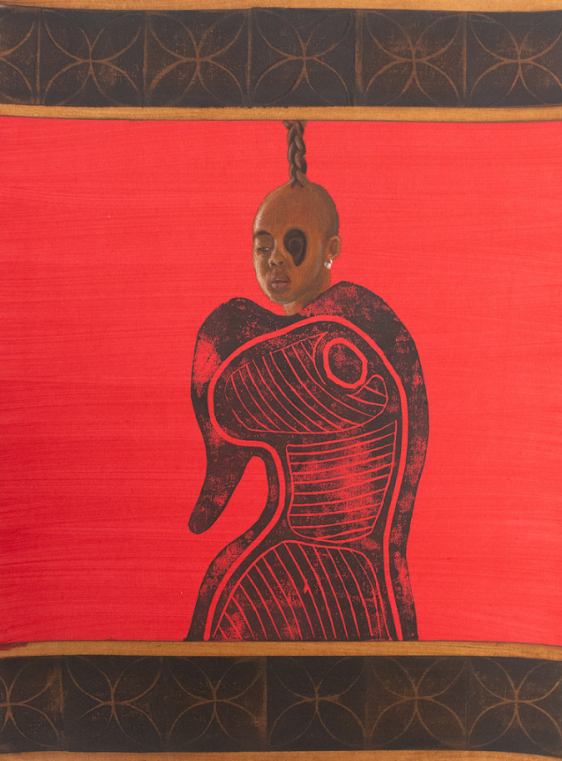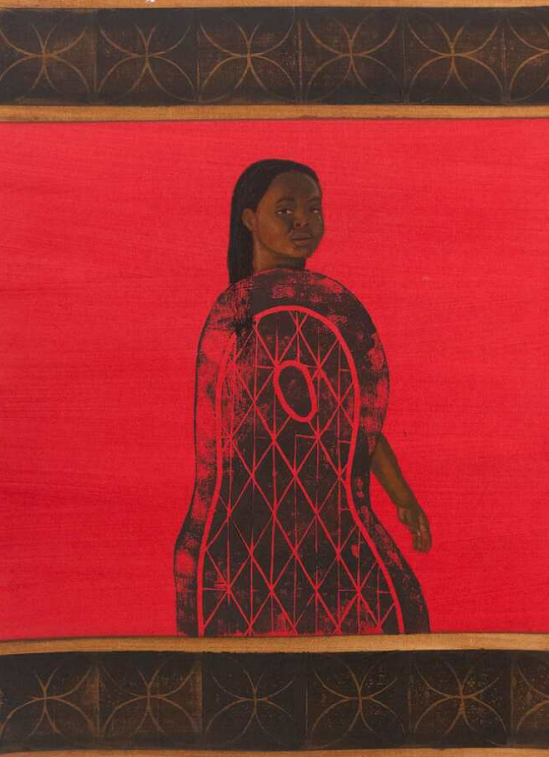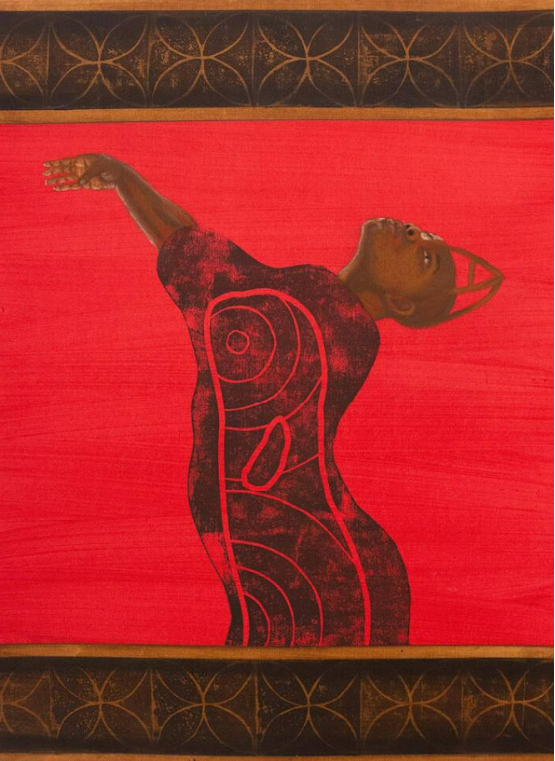In her first solo exhibition since receiving her MFA from the Ruskin School of Art, University of Oxford, as well as being selected for the Mansfield-Ruddock prize and New Contemporaries, Bunmi Agusto joined Arts Help in discussing her newest solo exhibition Lands of the Living at the DADA Gallery at Cromwell Place, London. Peeling back the veil on her ethereal world, Agusto gives us a glimpse through the window of her mind. Her works connect with the United Nations Sustainable Development Goal of Good Health and Well-Being and explore the self in novel ways.
In this interview, Agusto discusses her Lands of the Living exhibition, her process, as well as her motivations in creating a new, personal dimension to foster and house her creations.
You mentioned in previous interviews that some of your influences come from imagined worlds. Worlds with lots of characters and depth. Do the figures in the Within represent individual characters or are they used as signifiers for feelings, groups, or stories?
They're a bit of both, the main characters in my work are reflections of myself and segments of myself. But then I think of the self in a very wide sense because the genesis lore behind my work is that I was this alien when I was first born, this nameless being thrust into this reality called Ó. My ethnic group, the Yorubas, do not name their children until the seventh day so I, Olubunmi, do not come into existence until the seventh day. So for those first seven days, I was Ó. If you believe in multiple religious ideologies, Ó can be understood as a compound of past lives and ancestral coding. However, once Olubunmi was named, I became the vessel as Ó retreated into my mind and built the world now called Within. I accessed this world when I was 20 and then Ó and I planted some beings in braided cocoons. Eventually, eight hybrids emerged from those cocoons each born in my image but with mutations based on my upbringing and lived experiences.
For example, the character Umbanda, whose head forms the shape of an archbishop’s mitre, is in charge of spirituality. Aruaro, who has a second set of eyes nestled in her tribal marks represents my connection to my ancestry. The hybrids all have their own powers and purposes in the world that reflect different aspects of my personality.

Do these characters interact with each other in the Within? Are there visitors? How do they interact with the world around them?
The hybrids and Ó are native to Within. Olubunmi being myself is a visitor, any time that I feel I'm zoning out I'm visiting Within. This means that anytime that I am lost in my mind I’m in Within but when I’m in this reality, which I call the Outer World which Olubunmi came from through a portal at age 20. The way it works is for example when I’m speaking to you that's a perception that's going on in my mind and sometimes, they make their way through that portal and into Within. Humans then become these cross-reality migrants, with the hybrids and Ó being native and Olubunmi being a visitor and the other humans being figments of perception that also visit the world and they all interact with each other. You see them recurring in several paintings in a long narrative unfolding in my work.
You describe your work as evolving alongside you in different eras, with your most recent work you’ve used a lot more red. What does that represent?
The colours I use tend to reflect where I am at, they also tend to be what I’m drawn to at any given time. With my first exhibition, I used a lot of dark colours and oranges to introduce the world to people. Then I shifted to a few different colours before settling on green and brown, which were used when I was enhancing world-building and thinking of things architecturally. Now focusing on spirituality, reds, pinks and purples — this very unreal colour palette. I think the other colour palettes I’ve done have been quite grounded in the natural world. When talking about the speculative and the unknown we can guess as much as we can and that's what I'm doing. I'm kind of theorizing things, so when I'm having these very divine moments, they have these very unreal colour palettes.

How has the Within evolved alongside your own personal journey?
I was born and raised in Lagos, Nigeria. I am often miscategorized as a British-Nigerian, but I am just Nigerian. I moved to the UK when I was sixteen for educational purposes. I experienced quite a culture shock. I'd been to the UK very frequently prior, but it's different to visit somewhere for a holiday than to live somewhere. I ended up researching a lot of cultural theory at the time due to that culture shock. That is how I ended up creating the ‘aliens’ and ‘hybrids’ of Within because I was studying both the cultural and biological connotations of those terms.
Due to that miscategorization as British-Nigerian, critiques of my work in school often felt dissonant to me. So I began deeper critical research into a lot of Nigerian art and architecture I had experiential knowledge of. For example, I ended up looking at the architectural style of Tropical Modernism a lot because that is what felt like home to me. You can see lots of elements of that style in my work with the breeze blocks and thatched lines. The botany of the Within is primarily hair and clay-like skin. Therefore I had to (re-)create architectural styles using these materials in a fantastical manner.
After building these very physical components of the world, I shifted my gaze to the metaphysical. This shift also reflects the events of my life because my father and my cousin passed away in recent years so a lot of my recent research is born out of grief. I focused my MA History of Art & Archeology thesis on égungun masquerades — these are the masked performers that come out during Yoruba funeral rites. Therefore, I was looking a lot at the seen and the unseen in spirituality and found lots of parallels between religion and fantasy storytelling.
This is the research that led to Lands of the Living as a body of work. My father was Muslim and my mother is Christian, so I have always had this critical, untethered way of approaching religion. When building my work, I take a bit from Christianity, Islam, Yoruba and Buddhism and try to find the common ground between the religions.

Do you use the Within as a space or a tool to further understand yourself or for your audience to understand you?
It's a bit of both, I work in a very intuitive way. I don't really plan out my artwork very much. If you look at my sketchbook, you’ll find stickman-like drawings as opposed to full-on preparatory sketches. I make a lot of decisions on the paper. It's almost like an inkblot test in that the composition spills out of me and I decide what it means afterwards. There is an overarching, extensive narrative going across all my works, so I end up studying each work and trying to piece together where it sits in the narrative through my own lens.
In terms of using my work to understand myself, I can also tell when I'm shying away from a certain topic. For example, I made One Lizard, One Left after my cousin passed. At the time, it was very clearly about loss to me because it shows the trail of someone who is now off the frame and one figure being left behind. However, I ended up making Two Lizards The Day They Met which positions these two lizard characters as lovers instead. So I basically revised the story and changed it to one about a romantic heartbreak instead of a story about grief because I found the former easier to deal with than the latter.
You mentioned the Zaria Art School as being an influence for your works, are there any specific artists or works that influenced your series in this most recent exhibition?
Yes, particularly Uche Okeke and Bruce Onobrakpeya. I was generally thinking about the Nigerian modernist era including members of the Osogbo Art School like Susanne Wenger and Twins Seven Seven. At that time in post-independence Nigeria, the country’s national identity was being (re-)defined and the Zaria Art School introduced the idea of natural synthesis. Some people opted for a radical return to pre-colonial times, trying to ignore British colonial rule as much as possible. Some people had a colonial mentality and remained very loyal to British ideals. Natural synthesis opted for this middle ground which was just accepting reality. The idea was yes, we have our Indigenous cultures, but we can’t ignore hundreds of years of colonial rule either. So, it's about telling our own stories and borrowing from the West, where useful, but giving it this hierarchical authority over indigenous ways. It acknowledges the reality of history and how messy it is.
Looking at my work, I take a lot from what people consider disparate influences but I tend to see how they are directly linked. For example, video games and ancient civilizations. To me, they are both examples of world-building that use similar visual techniques because the latter influenced the former. There are parallels between the 2D plane of Super Mario Bros and hieroglyphs. The Legend of Zelda would not exist without Greek and Roman mythologies.
